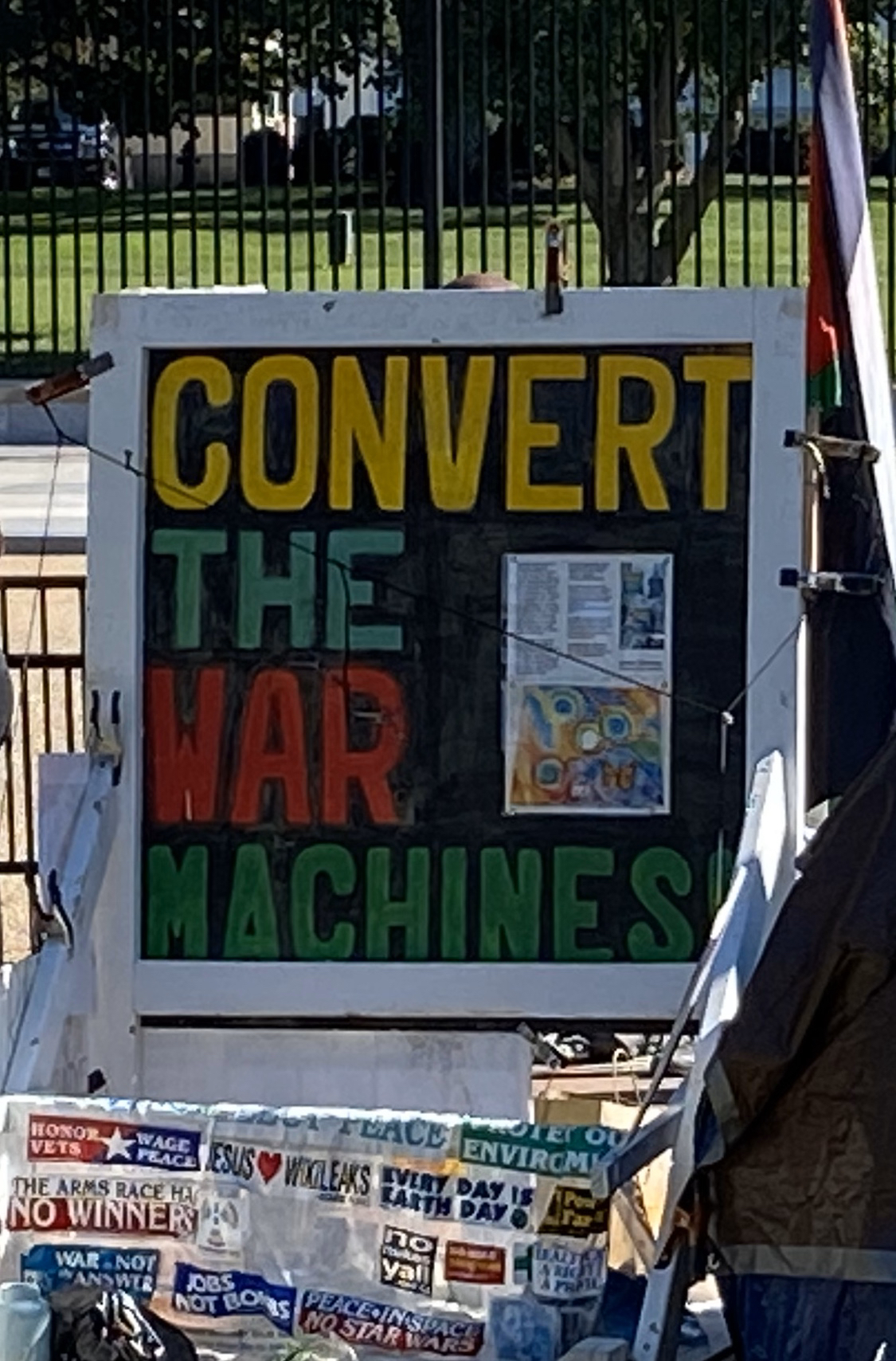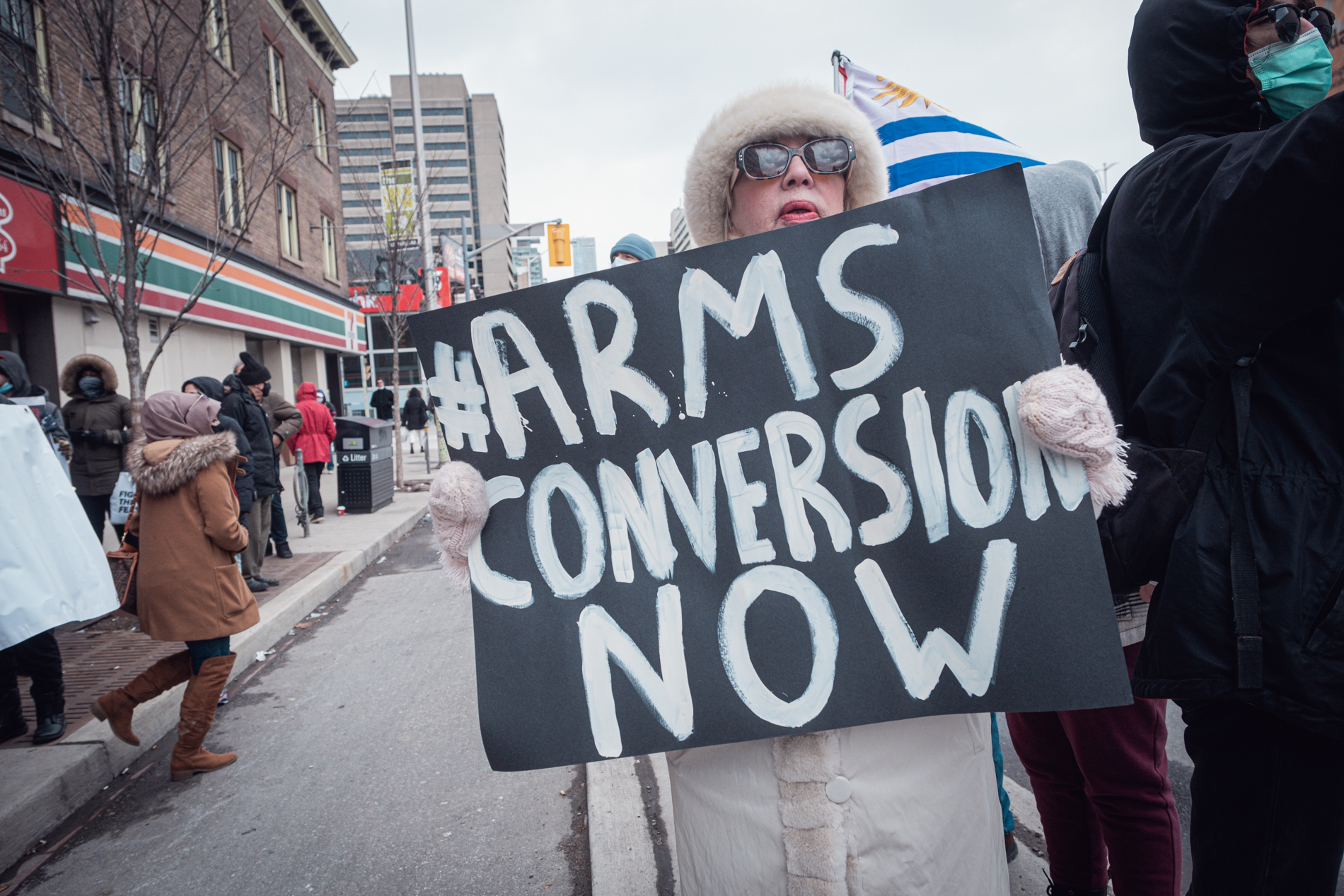The steps needed to convert military to peaceful industries without harming any workers, any broader economy, or anyone’s security have been known for many years. Legislation has been introduced in the U.S. Congress but not passed a great many times for decades — due to a lack of representation, because public support has been there.
Ocassionally, weapons dealers have manufactured a fear of military spending reductions that have not materialized, and state governments in the U.S. have done studies of the economic impacts of conversion, finding them to be positive.
During the 2020 COVID Pandemic, small instances of conversion demonstrated what could easily be done on a larger scale.
The basic reason that a conversion process would generate funding to spare for retraining and assistance to anyone impacted is that reducing military spending is economically beneficial, not harmful.
The broader case for a wide range of benefits and the debunking of fears about military reduction can also be useful here.
Here is an excerpt from A Global Security System: An Alternative to War:
Economic conversion requires changes in technology, economics and the political process for shifting from military to civilian markets. It is the process of transferring the human and material resources used to make one product to the making of a different one; for example, converting from building missiles to building light rail cars. It is not a mystery: private industry does it all the time. Converting the military industry to making products of use value to society would add to the economic strength of a nation instead of detracting from it. Resources presently employed in making weapons and maintaining military bases would be redirected to two areas. National infrastructure is always in need of repair and upgrading including transportation infrastructure such as roads, bridges, rail network, energy grid, schools, water and sewer systems, and renewable energy installations, etc. The second area is innovation leading to reindustrialization of economies that are overloaded with low-paying service industries and far too dependent on debt payments and foreign imports of goods once made at home, a practice that also adds to the carbon loading of the atmosphere. Old airbases can be converted to shopping malls and housing developments or entrepreneurship incubators or solar-panel arrays.
The main obstacles to economic conversion are the fear of job loss and the need to retrain both labor and management. Jobs will need to be guaranteed by the State while the retraining takes place, or other forms of compensation paid to those currently working in the military industry in order to avoid a negative impact on the economy of major unemployment during the transition from a war to a peacetime status. Management will need to be retrained as they go from a command economy to a free market economy.
To be successful, conversion needs to be part of a larger political program of arms reduction and it will require national level meta-planning and financial assistance and intensive local planning as communities with military bases envision transformation and corporations determine what their new niche can be in the free market. This will require tax dollars but in the end will save far more than is invested in redevelopment as states end the economic drain of military spending and replace it with profitable peace time economies creating useful consumer goods.
Attempts have been made to legislate conversion, such as the Nuclear Disarmament and Economic Conversion Act of 1999, which links nuclear disarmament to conversion.
The bill would require the United States to disable and dismantle its nuclear weapons and to refrain from replacing them with weapons of mass destruction once foreign countries possessing nuclear weapons enact and execute similar requirements. The bill also provides that the resources used to sustain our nuclear weapons program be used to address human and infrastructure needs such as housing, health care, education, agriculture, and the environment. So I would see a direct transfer of funds.
(Transcript of July 30, 1999, Press Conference) HR-2545: “Nuclear Disarmament and Economic Conversion Act of 1999″
Here is a Primer on Conversion by Mary Beth Sullivan from The Military Industrial Complex at 50:
It is my intention to stimulate some conversation about economic conversion — that is, planning, designing and implementing a transformation from a war economy to a peace economy. Historically, this is an effort that would include a changeover from military to civilian work in industrial facilities, in laboratories, and at U.S. military bases.
To that end, I intend to bring to you all what I’ve learned from reading Seymour Melman, the most prolific writer on the topic.
Seymour Melman was a professor emeritus of Industrial Engineering at Columbia University. He joined the Columbia faculty in 1949, and by all reports, was a popular instructor until he retired from teaching in 2003.
Melman was also an active member of the peace movement. He was the co-chair of the Committee for a Sane Nuclear Policy (SANE), and the creator and chair of the National Commission for Economic Conversion and Disarmament. It is reported that Melman was under surveillance by the FBI for much of his career because of his work criticizing the military-industrial complex — a sure sign that there must be something worth hearing in his work. What did he say that the power structure feared?
The economic conversion movement in past decades played a valuable role in bringing together the peace movement and union leadership to do the heady work of imaging how this country could sustain industrial jobs when, as it was envisioned, the U.S. would stop production of the weapons of the Cold War. It is a history that should not be forgotten.
Melman noted that U.S. industry had historically followed an established set of market rules: industry created products consumers needed, sold those products, made a profit, and turned those profits into improving production by upgrading the tools for more efficient production.
Military production for World War II began to change these rules of industry, which were then institutionalized in the 1960’s when Robert McNamara was Secretary of Defense. McNamara, who came to the Pentagon having been an executive at Ford Motor Company, implemented some critical changes.
Within the Pentagon, civilian and uniformed Pentagon officials were in conflict about the procedures for how to determine the costs of weapons to be contracted for manufacturing. On the one side, led by an industrial engineer, the idea was to base costs on the formulation of alternative designs and production methods, etc. — a competitive approach that promoted economy.
The other side proposed generating costs based on what was previously spent. For the Pentagon, this meant following the “cost-plus” system used during World War II, also known as “cost maximizing.”
As Melman put it, “contractors could take the previous cost of making a product for the Pentagon and simply add on an agreed-upon profit margin. The more a product cost, the more [a contractor] stood to earn.”
McNamara opted for this second option. The result was that by 1980, the cost of producing major weapons systems had grown at an annual rate of 20%. Melman observed that by 1996, “the cost of the B-2 bomber … exceeded the value of its weight in gold.”
McNamara went on to model the Pentagon after a corporate central office, defining policy, appointing chiefs of subordinate units, maintaining accounting and management functions with huge discretion. Each military service participated in the process of acquiring materiel and weapons. This process resulted in the tens of thousands becoming hundreds of thousands of employees, paid for by America’s tax dollars, to maximize the profits of weapons producers.
Melman minced no words in articulating the consequences:
An industrial management has been installed in the federal government, under the Secretary of Defense, to control the nation’s largest network of industrial enterprises … the new state-management combines … economic, political, and military decision-making.
…Nowhere in the Constitution is top economic power conferred by the Constitution.
The operation of a permanent military economy makes the president the chief executive officer of the state management controlling the largest single block of capital resources, including the largest aggregation of industrial facilities in the economy. Thereby, a core feature of a Leninist state design was installed in the federal government — top economic, political and military power in the same hands, often unconstrained by law.
…this combination of powers in the same hands has been a feature of statist societies — communist, fascist, and others — where individual rights cannot constrain central rule … .
Among the many critical consequences of this state controlled industry described by Melman, I’ll mention a few:
- Firms were no longer efficiency orientated — rather, industry produced increasingly complicated goods.
- Production had nothing to do with meeting the needs of ordinary consumers. Melman pointed out that a nuclear-powered submarine was a “technological masterpiece,” — but consumers can’t eat it; can’t wear it; can’t ride in it; can’t live in it; and can’t make anything with it.
- Labor lost control of any decision-making it had over production. With the influx of capital came an influx of white-collar middle managers, and an alienation — or disempowering — of workers.
- Where the U.S. was once a top producer and exporter of tools needed for production of consumer goods, the complexity of military production focused industry on specialized machinery and tools that have no utility in meeting consumer needs.
- The Pentagon consumed the talents of our scientists and engineers whose skills were needed in other sectors of our society.
In one of Melman’s last articles at the dawn of the 21st Century, his frustration was palpable. He noted that New York City put out a request for a proposal to spend about $3 billion to $4 billion to replace a number of subway cars. Not a single U.S. company bid on the proposal — in part because the U.S. no longer had the tools it needed to build its subway trains. In this article, titled “In the Grip of a Permanent War Economy,” Melman calculated that if this manufacturing work were done in the U.S., it would have generated, directly and indirectly, about 32,000 jobs.
Melman shared his vision:
The production facilities and labor force that could deliver six new subway cars each week could produce 300 cars per year, and thereby provide new replacement cars for the New York Subway system in a 20-year cycle — for the 6,000 railcar fleet of the NY subway system. … Well-trained engineers are required to design the key subway transportation equipment. Therefore, we must note that it is almost 25 years since the last book was published in the U.S. on [this topic.] … [This] is also true for every one of the industries targeted for deindustrialization during the second half of the 20th Century.
There was an alternative vision that was percolating within the economic conversion movement in decades past with an intent to create and begin the process of reducing the economic decision-power of the war-making institutions. This was to be done by mandating a planning process for the changeover from military to civilian work in factories, laboratories, and military bases.
The plan was to set up a highly decentralized planning process based on “alternative-use committees” to do the necessary blueprinting. Half of each alternative-use committee would be named by management; the other half by the working people. There would be support of incomes during a changeover.
Nationally, a commission chaired by the Secretary of Commerce would publish a manual on local alternative-use planning. It would also encourage federal, state, and local government to make capital investment plans, creating new markets for the capital goods required for infrastructure repair.
Three principal functions would be served by economic conversion.
First, the planning stage would offer assurance to the working people of the war economy that they can have an economic future in a society where war-making is a diminished institution.
Second, reversing the process of economic decay in U.S. manufacturing in particular (and in the rest of the U.S. economy) the National Commission would be empowered to facilitate planning for capital investments in all aspects of infrastructure by governments of cities, counties, states and the federal government, which would comprise a massive program of new jobs and new markets.[i]
Third, the national network of alternative use committees would constitute a gain in decision-making power by all the working people involved.
Melman worked with students, union leaders, the peace movement and with Congress to create momentum around these ideas. There were some key events along the way.
In 1971, George McGovern included the idea of economic conversion when he announced his candidacy for the Democratic Presidential nomination. His statement included this position:
Basing our defense budget on actual needs rather than imaginary fears would lead to [budget] savings. Needless war and military waste contribute to the economic crisis not only through inflation, but by the dissipation of labor and resources and in non-productive enterprise. …
For too long the taxes of our citizens and revenues desperately needed by our cities and states have been drawn into Washington and wasted on senseless war and unnecessary military gadgets .… A major test of the 1970’s is the conversion of our economy from the excesses of war to the works of peace. I urgently call for conversion planning to utilize the talent and resources surplus to our military … for modernizing our industrial plants and meeting other peacetime needs.
In 1976, SANE held a conference in New York City entitled “The Arms Race and the Economic Crisis.” Melman was a featured speaker. This conference was instrumental in winning an economic conversion plank in the Democratic Party platform that year.
In 1988 and ’89, Melman had several meetings with then Speaker of the House, Rep. Jim Wright. Wright convened a meeting of congressmen who were committed to support the economic conversion bill proposed by New York’s Rep. Ted Weiss. Speaker Wright told Melman that, in his opinion, the arms race had taken on not only dangerous but also economically damaging characteristics, … and that spending on the military was a burden that sapped the strength of the whole society.
On the first day of the opening of the 101st Congress, Speaker Wright convened a meeting of members who had proposed economic conversion legislation, and their aids. The purpose was to ensure that all proposals be joined into one, and that this legislation be given priority. To dramatize the importance of this bill, it would be given number H.R. 101.
Melman and SANE were elated. And then reality hit. As Melman reported:
Supporters of such an initiative did not reckon with the enormous power of those opposed to any such move toward economic conversion. In the weeks that followed, these vested interests waged a concerted and aggressive campaign in Congress and the national media to bring down Jim Wright over allegations of financial misconduct.
The allegations had little substance, but Newt Gingrich, representing a headquarters district of Lockheed Martin, led the Republican attack. Sadly, they won. According to Melman, “Their media campaign drowned out any further discussion of economic conversion .… A historic opportunity had been destroyed.”
I found an article written in 1990 from the LA Times, which reported about economic conversion plans developing in California and beyond. It included the following hopeful news:
Irvine, California Mayor Larry Agran, planned to make his home town a national model for economic conversion by using what all presumed would be “under-worked” defense companies to build a major monorail project. He envisioned a major local mass-transportation industry. His proposed Irvine Institute for Entrepreneurial Development would also look for ways to push local rocket scientists toward environmental cleanup, health care and other such enterprises.
In Los Angeles, Councilwoman Ruth Galanter, with the support of the International Assn. of Machinists, convened a committee to study prospects for converting aerospace jobs to establishing an electric car-manufacturing industry. They argued that there were linkages in technologies and skills across industries.
On the state level, California Assemblyman Sam Farr promoted a package of bills that required the governor to 1) convene an “economic summit” on conversion, 2) appoint a council to study the issue and 3) come up with a means of facilitating the transfer of military technology to the civilian sector.
Finally, at the federal level, Representative Ted Weiss from New York continued to push economic conversion legislation until his death in 1992. To my knowledge, no other Congressperson has taken on this issue.
George H.W. Bush’s attack on Iraq in the 1990 Persian Gulf War was a critical nail in the coffin of the national economic conversion movement.
There are some in the peace movement who continued to keep the embers of economic conversion alive. Many years ago in Groton, Connecticut, the local peace community organized a “listening project” to engage the community in conversation about what economic conversion might look like for General Dynamic’s Electric Boat Company, builder of submarines for the U.S. Navy. For more than 30 years, the Peace Economy Project in St. Louis has been advocating for conversion from a military to a more stable peace-based economy locally. The Woodstock peace community held a conference in 2009 focused on the conversion of Ametek/Rotron, a Woodstock manufacturer that makes parts used in F-16 fighter planes, Apache attack helicopters, tanks, and missile delivery systems. Certainly there are others out there engaging their home communities in envisioning alternatives to continued production for endless war.
My partner, Bruce Gagnon, is the coordinator of the Global Network Against Weapons and Nuclear Power in Space. He has been organizing around conversion since the 1980s. His typical question to any audience is: “What is the U.S.’s number one industrial export?” Audiences across the country shout out “weapons.” He then asks, “When weapons are your number one industrial export, what is your global marketing strategy?” “Endless war” becomes the refrain.
In 2003, Bruce and I moved to Maine, in part to be near Bath Iron Works (BIW), the General Dynamic’s owned production facility for naval destroyers that are deployed with Aegis weapons systems. These Aegis destroyers are part of the “Star Wars” or “missile defense” vision; they rely on space satellites when launched toward their targets. Bruce and I joined the vigils that peace groups organized in Bath, and Bruce organized some vigils for the Global Network. We would hold signs critical of the purpose of the Aegis destroyer (Aegis is not about defense; Aegis destroys) and would offer an alternative vision for the factory (build wind turbines, not destroyers).
Initially, people laughed, scoffed, scorned, and some spewed hateful things at us.
In 2007, Bruce and I moved to Bath with our friend Karen Wainberg. We bought a big old house; tore down a wall to create a community room; and began conversations in our home about the idea of economic conversion. We interviewed people who had lived in the community for a while. We interviewed some workers at BIW.
In fact one worker, Peter Woodruff, joined our “conversion study group” early on. Broken-hearted by the role of the Aegis destroyers in the shock and awe campaign on Iraq, Peter has been a brave and creative organizer inside BIW. He plays with designs for creating energy through using tidal power; he has been an avid supporter of wind power using offshore wind turbines. Peter has bravely organized petition drives, created bumper stickers, publicly posted articles that educate his colleagues to the reality of the situation. He also spends two hours a week, with Bruce Gagnon, hosting a radio show on the campus of the local private college that espouses an anti-war theme, including conversations about economic conversion.
As BIW copes with episodic layoffs, a diminishing need for more U.S. war ships, and workers are feeling some job insecurity, fewer people scoff at our signs and message. Envisioning a future for BIW in a peace economy is an essential asset to the community.
Meanwhile, there is momentum in Maine to generate wind power options. A professor at the University of Maine is experimenting with composite materials to create a prototype for an offshore wind turbine, and a former governor has created a private company to put wind turbines throughout the state. As a friend who was an employee at BIW many years ago points out, BIW did convert years ago — from making commercial ships to naval destroyers. Can it experience another conversion now, making wind turbines and other renewable energy products?
What if BIW converted to making hospital ships? Paul Chappell talked to us here at this conference about transforming the U.S. military into a humanitarian relief organization. Maine author Kate Braestrup spoke at Maine’s Veteran’s for Peace PTSD conference this year. She told the story of her Marine son who has experienced a number of deployments focused on disaster relief. She asked him how he can do humanitarian relief when the equipment they carried were instruments of war? He told her it took some creativity, but they were able to transform their equipment to rebuild infrastructure. Braestrup then asked this question: given that devastating extreme weather events will continue to occur, why don’t we build hospital ships at BIW to meet the need in disaster relief — and if we need to adapt the materiel to fight wars, we can figure out how to do that?
It behooves the peace movement to create a vision that the populace can get excited about — a vision that will capture people’s imagination. A vision that sees skills and talents of our engineers and scientists creating the renewable energy infrastructure that is critical to surviving the 21st Century; a vision that engages peace activists, environmentalists, labor, students, artists, and food security folks in creating plans for how we will heat homes, feed people, transport people in the year 2040. This is the true security need for the U.S., and the world.
Karen Kwiatkowski shared an important admonition at the conference. The MIC culture of cost maximizing/ cronyism/ lack of accountability (and, as Melman noted, worker alienation) makes its factories an unlikely location for the rebuilding of a worn-out infrastructure and creating the new energy models. Perhaps we are talking more about reconstruction than conversion. But it behooves each of us — locally — to look around, determine the needs, create the collaborations, and wrestle the funds away to start building a survivable future.
Economic conversion is an idea whose time has come. As evidence, I submit that we have an ally in none other than Deepak Chopra, the preeminent leader in the field of mind-body medicine. Few people know that, after the 2008 election, Dr. Chopra sent a public letter to Barack Obama which he called “Nine Steps to Peace for Obama in the New Year.” Asserting that it was an anti-war constituency that elected Obama, Dr. Chopra invoked the spirit of Dwight D. Eisenhower in insisting Obama move from an economy dependent on war-making to a peace-based economy. Dr. Chopra’s recommendations included: writing into every defense contract a requirement for a peacetime project; subsidizing conversion of military companies to peaceful uses with tax incentives and direct funding; converting military bases to housing for the poor; phasing out all foreign military bases; and calling a moratorium on future weapons technologies.
The vision is clear, it is obvious, it is mainstream. An important next step for us is to determine what we can do in our home communities to empower local unions and workers, environmentalists, health care workers, social workers, spiritual leaders, and the neighbors next door to engage the debate.








